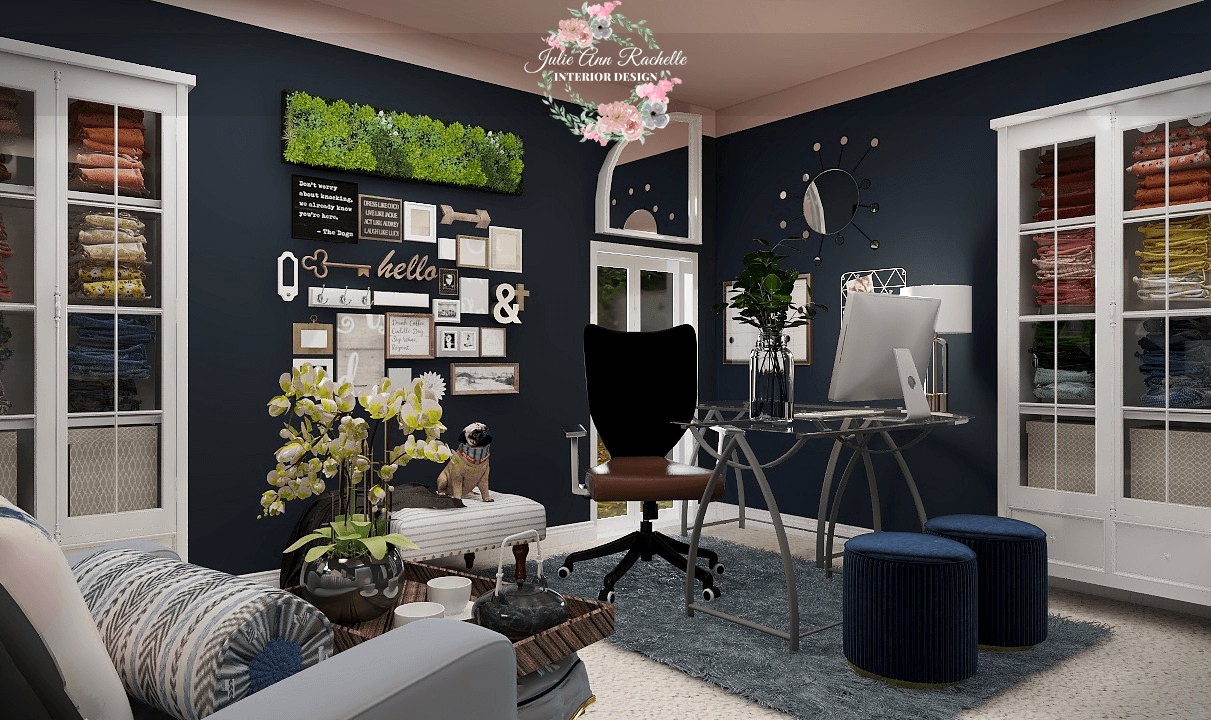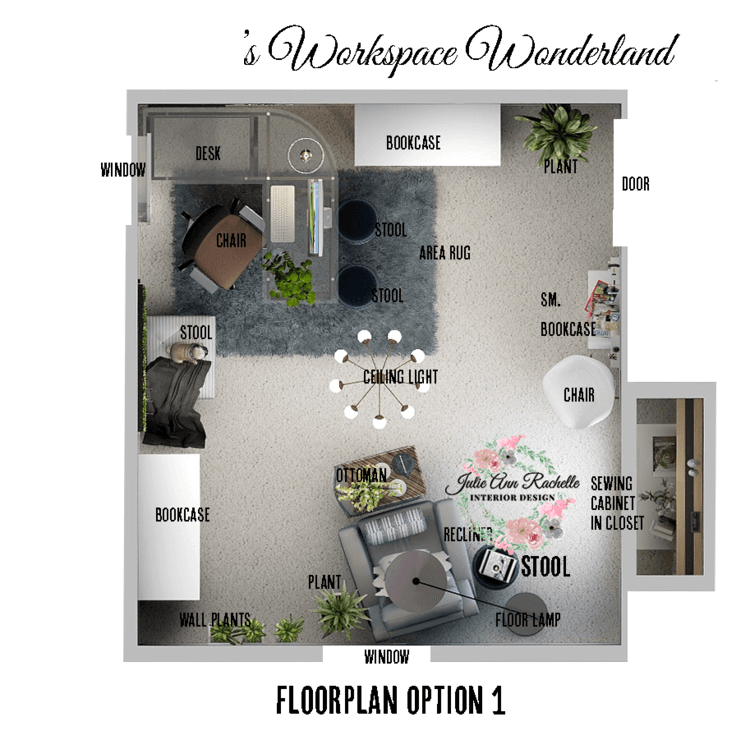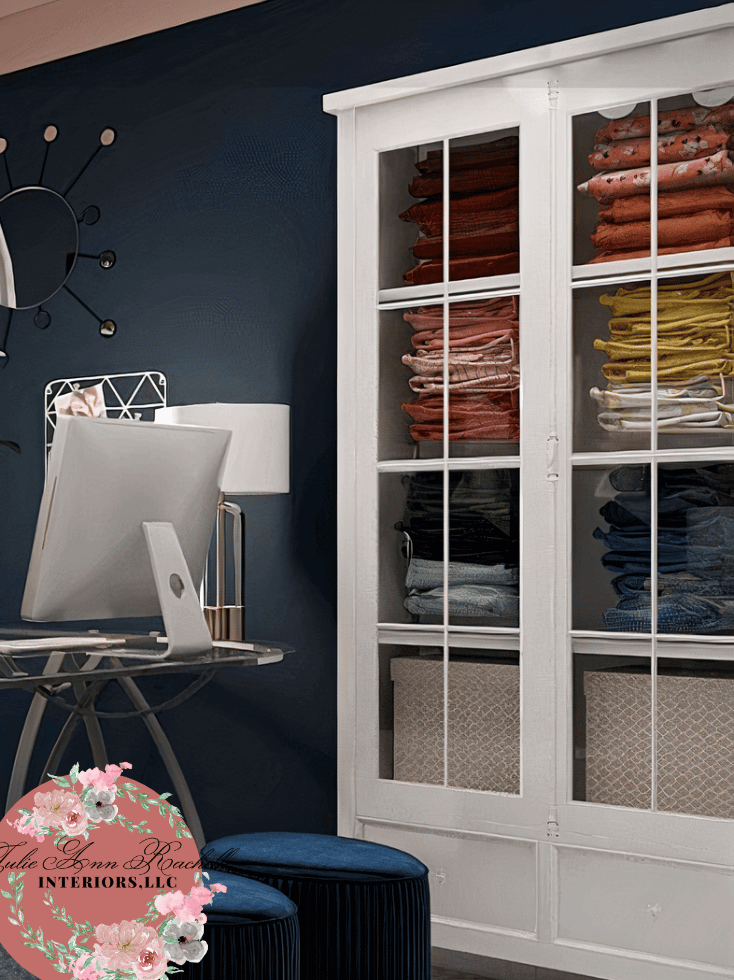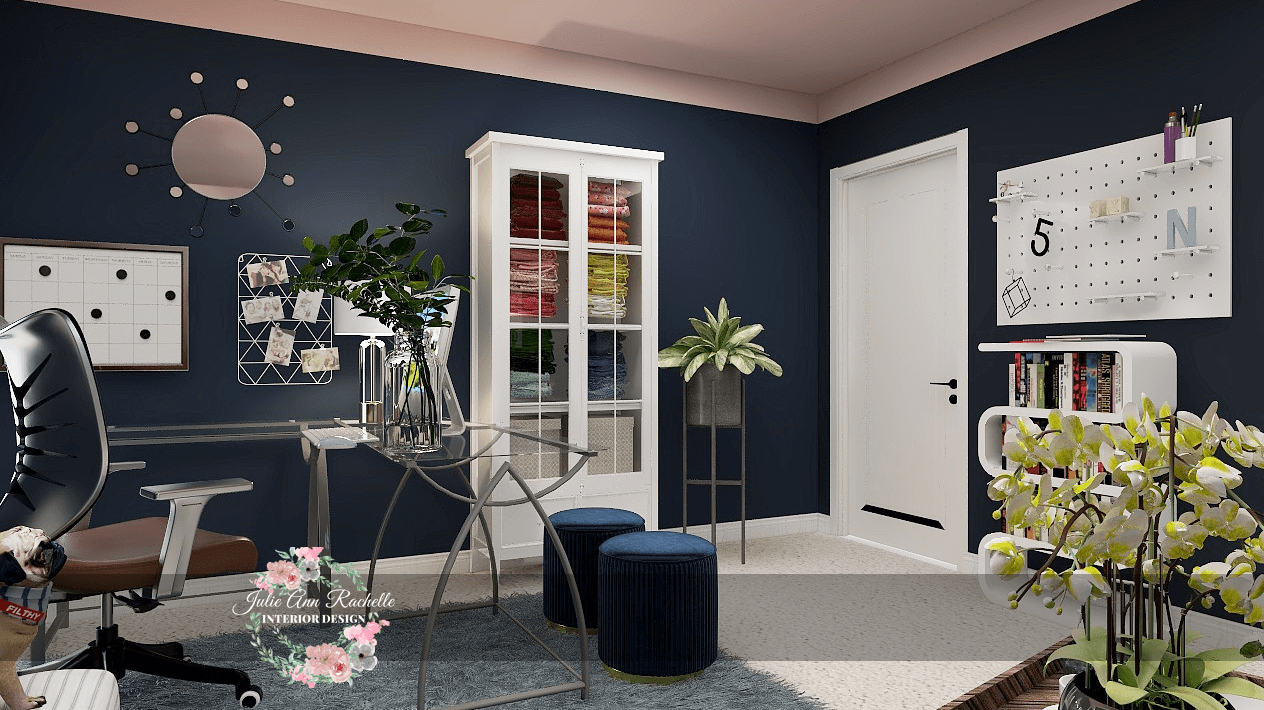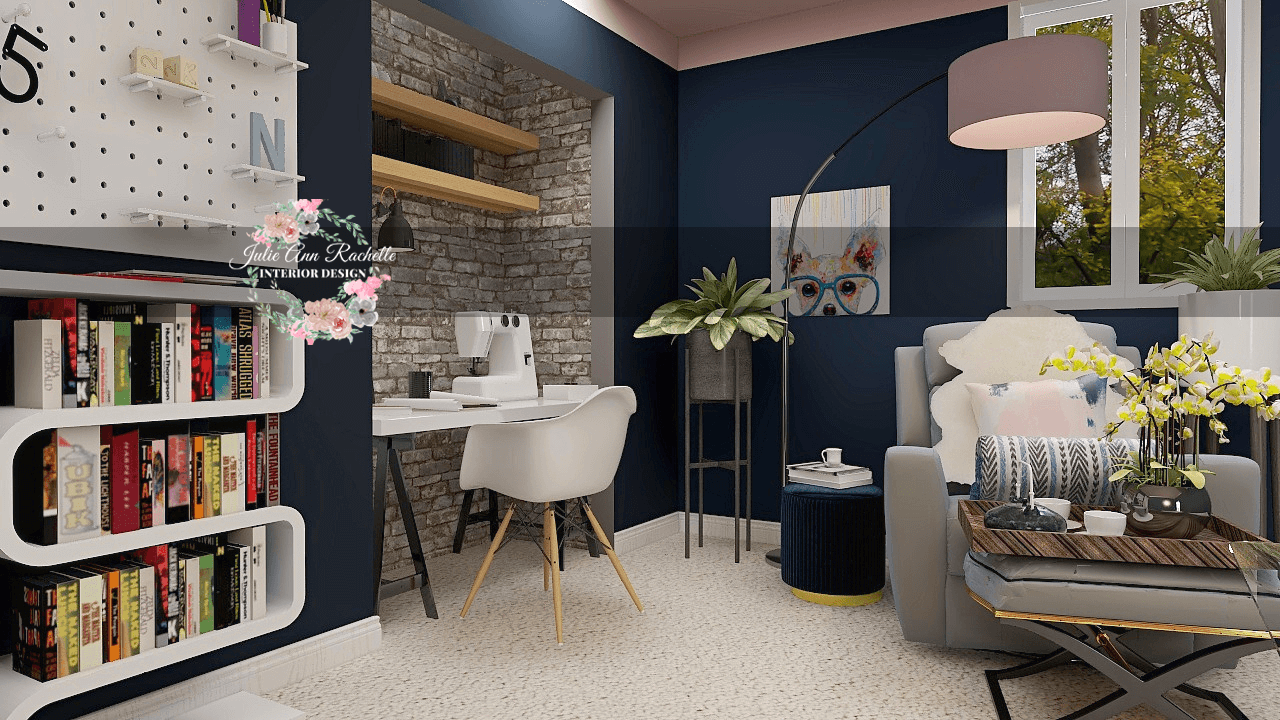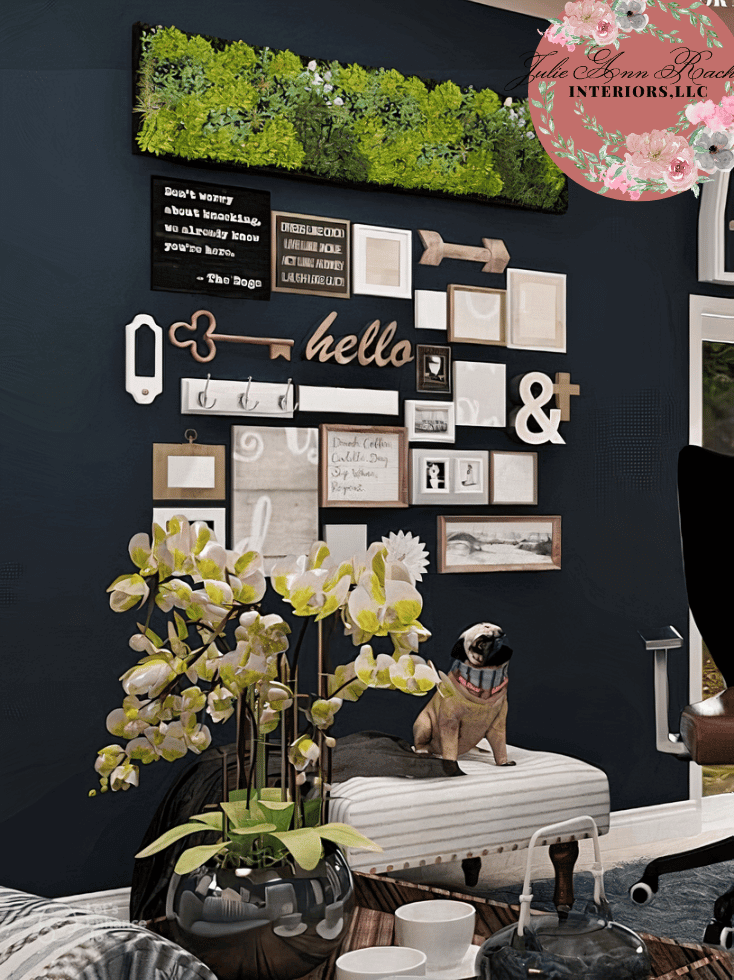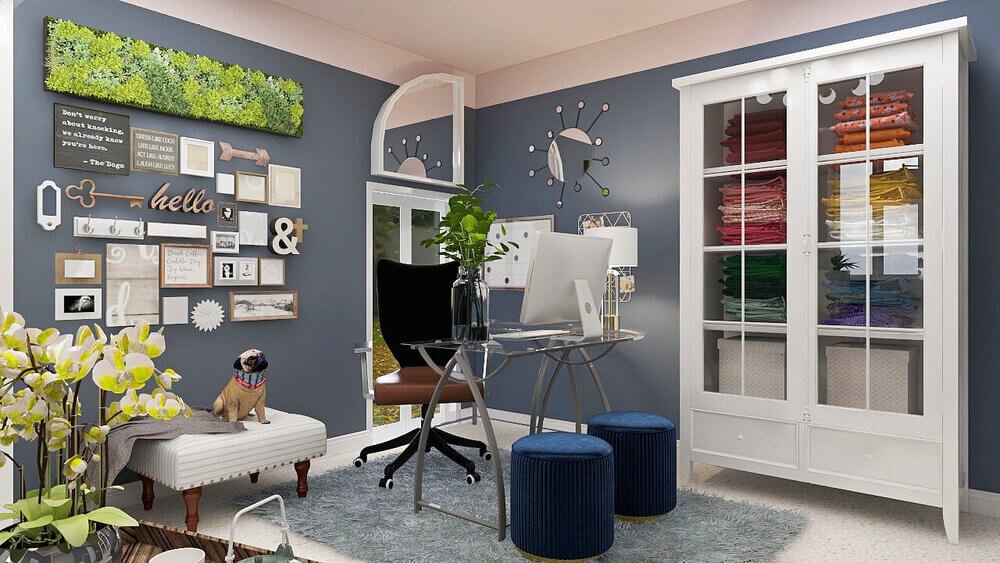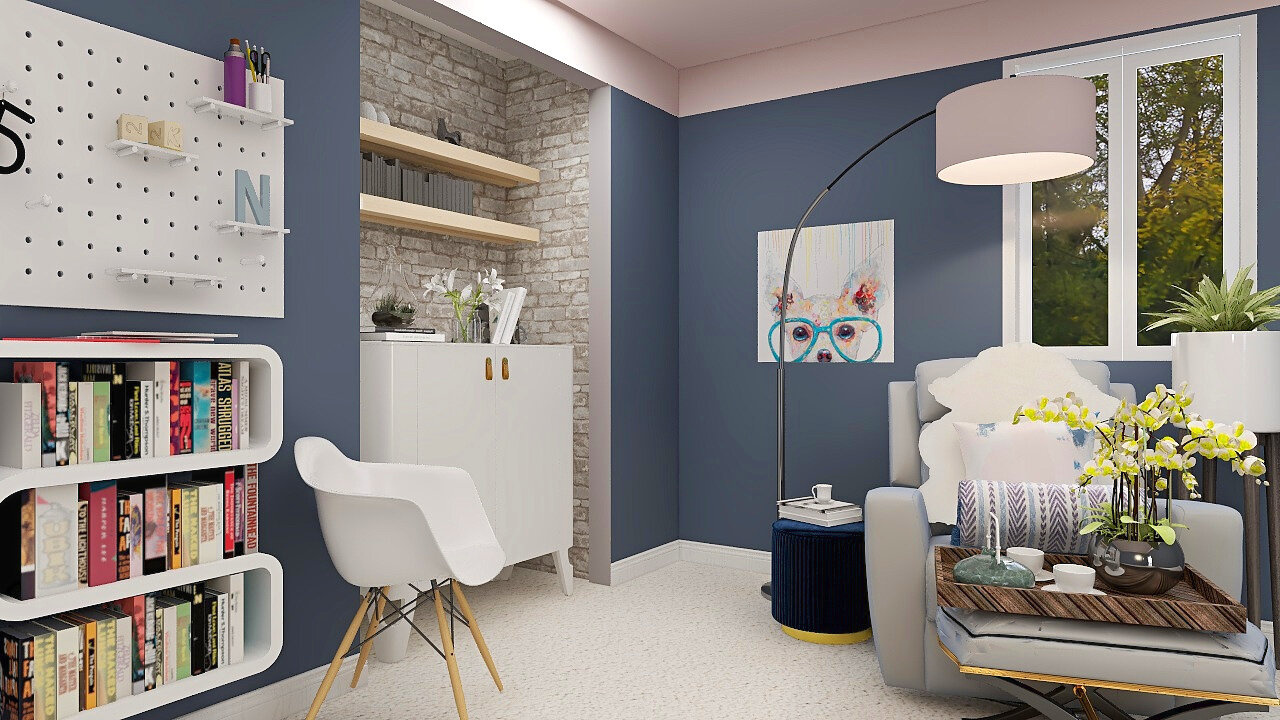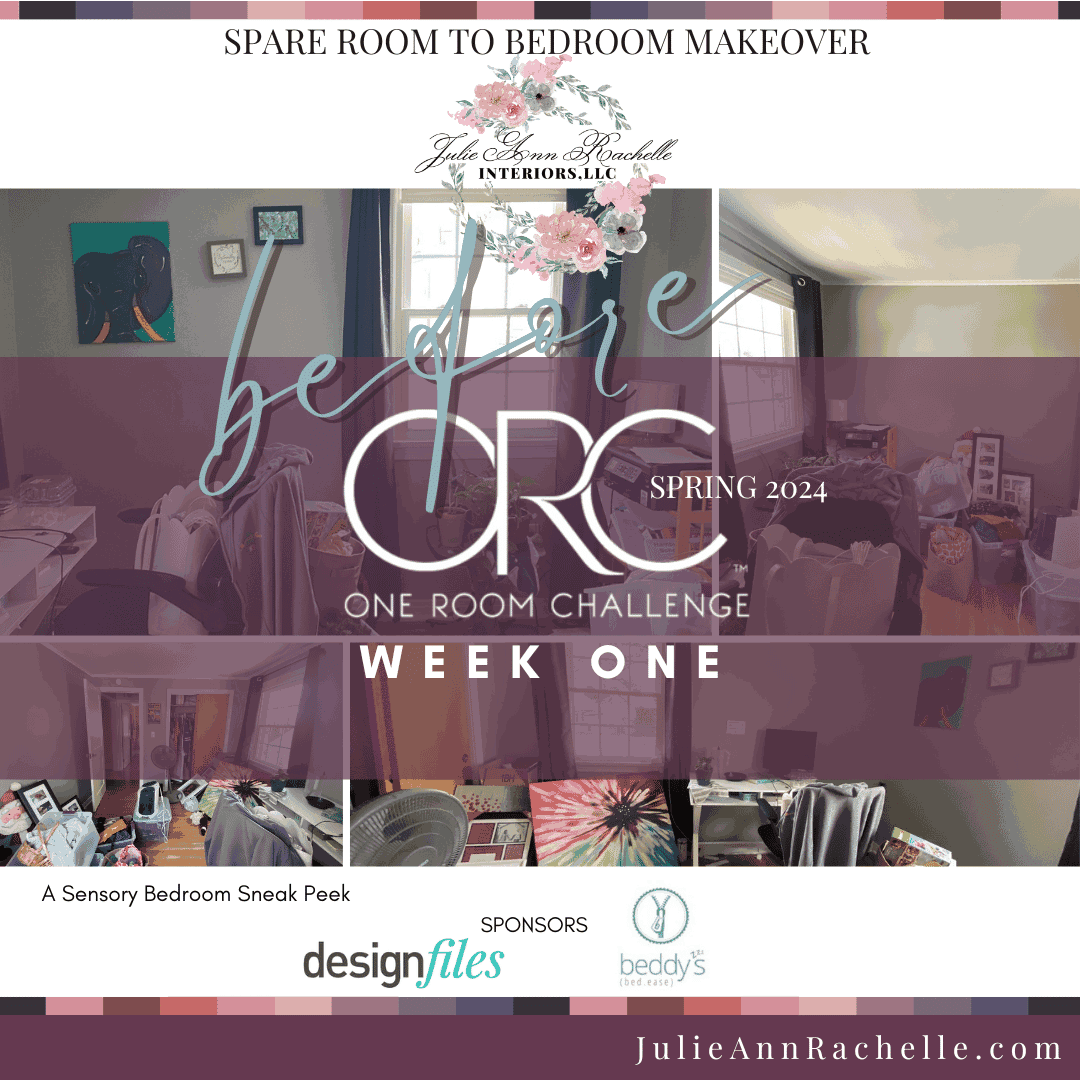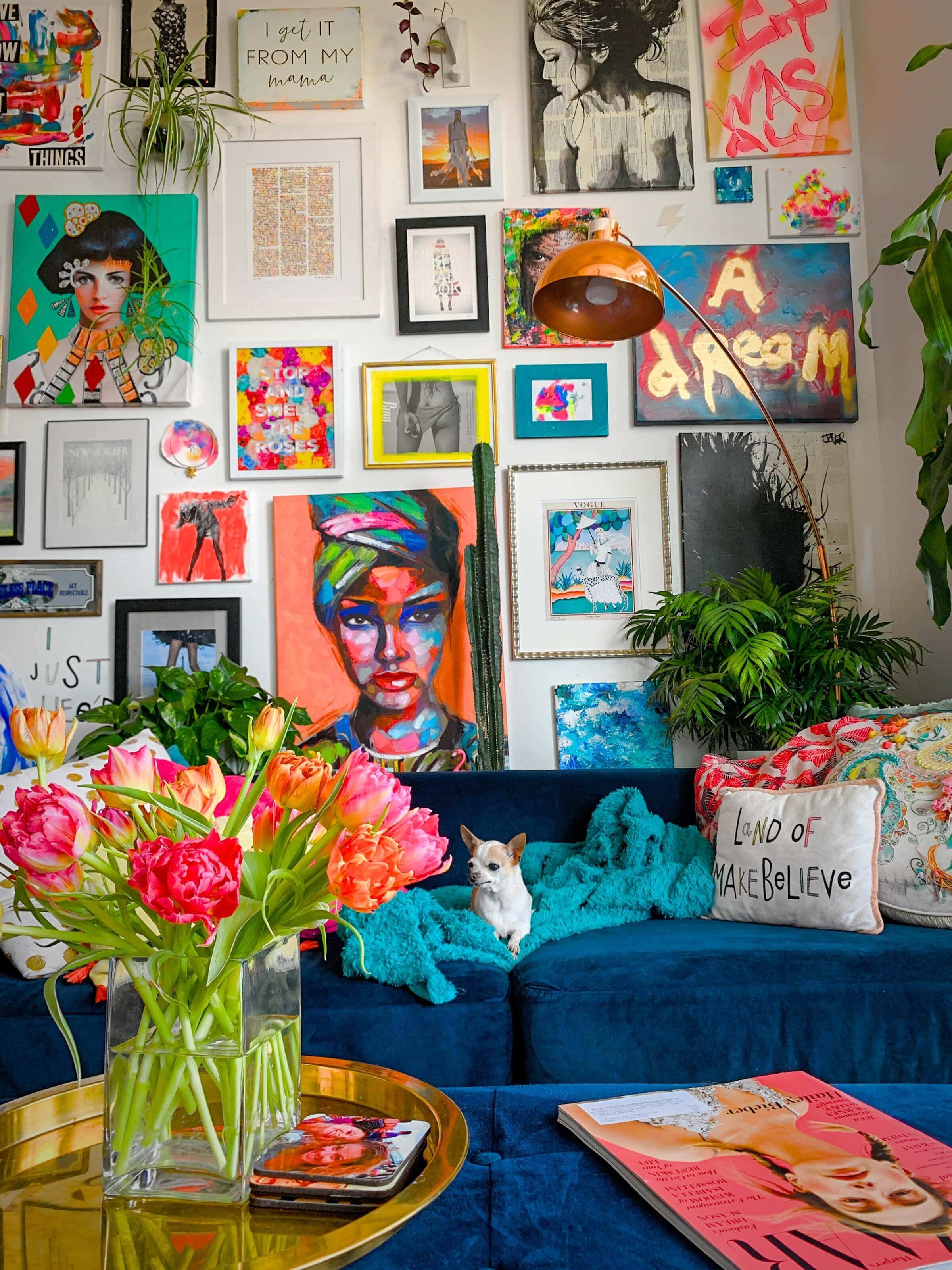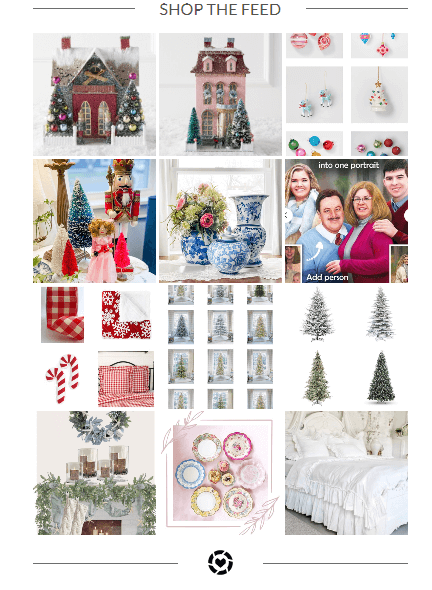How to Create a Zoom-Worthy Home Office and Sewing Room
What To Consider When Combining a Home Office and Sewing Room
Home Office & Sewing Room Project of eDesign Client in Baltimore, MD. Design: Julie Ann Rachelle Interiors LLc
If product images fail to load, please refresh the page.
In the wake of the global pandemic, our professional lives have undergone a profound metamorphosis, compelling us to reimagine the structure of our domestic workspaces, imbuing them with organizational finesse and aesthetic charm.
Within this paradigm shift, the passionate community of stitching enthusiasts faces the arduous task of harmonizing their fervor for needlecraft with the demands of professional obligations.
This post sets the stage for creating an effective domicile, aptly merging productivity and creativity, ultimately manifesting in an office and sewing accommodation that exudes practicality and Zoom-worthy allure.
Irrespective of whether you have already established yourself in your chosen vocation or are embarking on a novel telecommuting experience, this discourse promises an array of invaluable insights to envision while sculpting an optimized workspace and hobby haven.
We will explore all the essential elements required to transmute your physical room into a habitat that engenders comfort, invigorates your work rate, and propels you toward success.
You will also enjoy these related articles:
Items to consider when mixing an office and a craft room
Design by Julie Ann Rachelle Interiors LLC
Embarking upon the intricate endeavor of meritoriously how to design a home office and sewing room necessitates comprehensively contemplating numerous variables, ensuring their optimal coexistence and mutual enhancement.
The magnitude of space allocated to each pursuit, the quest for ergonomic excellence in furniture selection, the divergent storage provisions catering to the vast constellation of crafting paraphernalia alongside the mandatory requisites of an office, the meticulous orchestration of illuminative arrangements that benefit both vocations with utmost precision, the perplexing decision between monochromatic unity or an energetic kaleidoscope of hues permeating the air, the artful implementation of noise-dampening methodologies to foster steadfast focus amidst the dual domains of diligent work and fanciful expression, the meticulous calibration of hobby equipment in harmony with the furnishings of the office/sewing room, and the seamless interplay of decorative elements that unite and harmonize this symphony of duality—these multifaceted considerations intricately weave the tapestry of our profound discourse.
Key points
To supplement craftship and make sure the two zones complement each other, you'll need to plan out carefully:
how much room you'll need for each activity,
the comfort level of furniture,
what storage solutions will be used for craft supplies versus office supplies,
what type of lighting works best for both tasks, to stick with one color scheme or use multiple colors,
what noise reduction resolutions have to be implemented so that you can fixate on work and crafting endeavors,
how much office/craft room supplies have got to be stored in the office, and
how décor can tie it all together.
To exemplify, to embroider an aura suffused with luminosity and airiness, the veritable orchestration of lighting assumes paramount significance.
A judicious fusion of natural radiance, artificial brilliance, and task-specific luminance must intertwine harmoniously to actualize working conditions that ignite the flames of creativity.
The ingenious arrangement of cache contrivances and the artful deployment of peg boards are tasked with ascending as sentinels of order, meticulously organizing your arsenal of creative pursuit equipage.
A separate enclave, revered as the ward of executive toil, must boast a spacious expanse crowned by a resplendent desk, an indulgently ergonomic chair, and generous repositories to cradle the emblems of your corporate existence.
As for the mysterious realm of chromatics, the beguiling infatuation of neutrals, with their inherent capability to instill tranquility, often assumes the mantle of choice.
At the same time, well-considered splashes of accent hues beckon the soul into an inviting embrace.
Finally, the sacred stronghold of sonic stillness beckons, wherein the enveloping hug of curtains, the tapestry of a plush rug, and the ethereal presence of acoustic panels converge to stifle discordance, bestowing upon the consecrated sphere the cardinal serenity required for steady concentration.
Key Points
Concentrate on:
lighting
a mix of natural, artificial, and task lighting
intelligent storage measures
peg boards
Launce a separate office zone:
a spacious desk
comfortable chair
storage for office supply
Don't forget about:
tranquilizing neutral colors
delectable feature colors
soundproofing materials such as curtains, rugs, acoustic panels
1. Space
Decide on the right room in your home to be your office/sewing space.
Deliberating upon the most suitable room within your abode as a versatile office and sewing space compels diligent consideration.
It is imperative to discern the finest setting, as the age-old wisdom of "location, location, location" remains paramount, even in this context.
Commence the process by contemplating the spatial requirements for your dressmaking endeavors and cyber engagements whilst also studying the fitting mood you wish to develop.
Do you prefer a home office sewing room with abundant natural light, or does a more formal and composed backdrop grab you?
Reflecting on these aspects enables you to determine the most adaptable environ that aligns with your dispositions and caters to the sensibilities of your Zoom audience.
Furthermore, ensure that the chosen room contributes to peacefulness and lessens distractions.
Implement measures to mitigate disruptions, such as limiting the presence of video games or addressing the attention-seeking tendencies of your beloved pets.
You will set up an impeccable home office sewing room combo suitable for needlework processes and Zoom meetings by orchestrating a serene and focused temperament.
As time progresses, experts in real estate foresee a future where homes, particularly in the post-pandemic era, engage in compact yet functional home offices.
These areas may involve a management area with a desk and even dedicated spaces for educational pursuits to accommodate the warrants of children.
Sewing enthusiasts, in particular, can leverage these emerging trends to materialize a room that uniformly integrates a sewing studio and an orderly home office.
Crafting can be a profoundly engaging and gratifying hobby, whether pursued for beautifying purposes or to sell products.
However, to embark on this visionary expedition, doggedly evaluating the spare space within your home is requisite.
If the existing room proves insufficient, exploring alternative answers, such as shared workspaces or renting a dedicated studio, emerges as necessary.
By broadening your search, you increase the chances of finding a milieu that caters to your creative passions and recompensed preconditions.
Additionally, when envisioning the layout of your office-craft hybrid room, it is vital to examine the size of each designated workspace, the functionality of the crafting area, and the incorporation of all necessary implements and staples.
Adequate lighting, well-designed shelving, and comprehensive storage provisions ensure you have everything you need to indulge in your pioneering enterprises.
By embracing these intricate appraisements and skillfully blending work and panache, you can forge an idyllic refuge where your stitching skills flourish and your online interactions thrive.
2.Comfort
When working from home, the significance of ergonomics cannot be overstated when it comes to the coziness and complexity of the sewing zone.
A deep understanding of human biomechanics, encompassing height, reach, joint angles, and weight tolerance, is pivotal in designing a setting that optimizes efficiency, even minimizing discomfort.
Functionality entails creating a workspace for stitching that facilitates a straightforward approach to impedimenta and supplies, simultaneously promoting good posture and overall body contentment.
By incorporating rules of good ergonomic design, you can strikingly amplify your crafting experience by crafting a workspace that brings enjoyment and downsizes disruptions.
Investing in ergonomic furnishings and fixtures that can be adjusted to meet individual concerns is pivotal to achieving relief and convenience.
This customization boosts labor at the same time minimizing the physical strain that can arise from prolonged sewing sessions.
3.Practicality
When generating an office and craft room, thinking realistically and visually is fundamental.
Useable particulars involve storage amenities like shelves and labeled buckets or boxes, substantial counter space, good lighting, and cushy seating options.
An organized workspace can increase productiveness and improve the vibe by inserting art, greenery, or collected memorabilia throughout the office.
How much space is available should be taken into account.
What furniture will be included?
Which items are necessary to purchase for the room and which items can DIY?
How does budgeting play a role in designing the space effectively?
4.Noise Reduction: home office sewing room with soundproofing
When combining an office and craft room, cacophony abatement must be examined.
Especially for stitching, as a sewing machine can be pretty noisy.
At the same time, you want to keep out din from auxiliary rooms when making a Zoom call for work.
The materials used for furniture and walls can impressively impact the acoustics in this type of domain.
Soundproofing insulation and foam sheets can also help mitigate the sound reverberating off surfaces.
Finally, flooring is also vital in limiting excess sounds.
Installing carpets or rugs with padding underneath can assign some relief from echoes, making for a quieter office-craft room combo.
5.Storage
The place where your supplies are is central when engineering a home office that will also function as a sewing room.
Here are some things to keep in mind when conceptualizing a stockpile area for your home office/sewing room:
Identify your storage challenges: Identify the bits and bobs you need to store in your home office/sewing room.
Such items may comprise office supplies, stitching tools, fabrics, patterns, and books.
Make a list of these things and their dimensions to determine the types of storage units you will need.
Maximize vertical space: In a home office sewing room for small spaces, it is imperative to augment vertical magnitude.
Entertain installing shelves or cabinets that arrive at the ceiling.
Additional storage will give you more space without taking up valuable floor space.
Implement multifunctional furniture: Look for furniture pieces that fulfill multiple purposes.
For example, a bookshelf can double as a storage unit for fabric or office supplies.
A desk with built-in storage can keep your stitching accouterment organized meanwhile providing a workspace for your computer.
Use drawers and bins: Drawers and bins are great for storing minuscule bits like buttons, zippers, and thread.
Use clear bins or label each drawer to make it easy to find what you need.
Keep frequently used items within reach: Tuck scissors or staplers, etc., within an arm's stretch.
This will save you time and make your workspace more streamlined.
Give thought to the type of storage: It is needful to keep fabrics in a cool, dry situation that is not exposed to sunlight.
This will help prevent fading and damage.
Use plastic bins or garment bags to keep fabrics organized and protected.
6.Lighting
When conceptualizing a home office sewing room combo, the importance of lighting cannot be overstated.
Thoughtful reflection of lighting principles improves productivity, reduces eye strain, and impels ease of work.
Here, we present a numbered list of components to review when denoting lighting for your home office/sewing room:
Natural light: Situate your desk and sewing machine near a window to harness the benefits of natural light.
Apart from providing bounteous illumination, this arrangement allocates pleasant views and the invigorating freshness of the outdoors.
Task lighting: Pair natural light with task lighting that illuminates your work area effectively.
Speculate on incorporating desk, floor, or pendant lights to supply concentrated lighting.
Opt for accommodating light sources that can be directed precisely to locations.
Strategic light fixture placement: Deliberate on the sections within your home office/sewing room where lighting is most integral.
Strategically direct lighting fixtures to nail down an even and consistent incandescence across your workspace.
Color temperature: The color temperature of your selected lighting appreciably impacts the room's demeanor.
Cool white light imparts an energizing ambiance, unlike warm white light that forms a cozy feel.
Opt for the color temperature that aligns with the coveted mood in your workspace.
Light control: The ability to control the brightness of your workspace is essential.
Incorporate dimmer switches or adjustable lamp shades to modulate the intensity of lighting based on your definite necessities.
Glare avoidance: Glare can lead to eye stress and hinder your ability to see your work.
Distribute lighting fixtures to avoid glare on your computer screen, sewing machine, or work surface.
Utilize light diffusers or shades to soften harsh light and minimize glare.
Lighting for storage areas: Do not overlook the importance of lighting in your storage compartments.
Adequate illumination assures easy reading and organization.
Evaluate using under-cabinet lighting or a track lighting system to endow fixed lighting for your storage scopes.
By deliberately considering these factors when deciding on lighting for your home office/sewing room, you can execute an enjoyable, functional, and highly productive room.
7.Color Scheme
Deliberating upon the perfect paint color is mandatory when contriving a home office that also serves as a sewing room.
The color you settle on for the walls can profoundly impact your mood, outturn, and initiative.
Here are several vital specifics to bear in mind when stipulating paint colors for your home office/sewing room:
Function of the room: Analyze the defined activities you will engage in.
If you anticipate spending extraordinary time on the computer, opt for a relaxing color that lowers eye strain.
Conversely, if stitching will be your primary focus, handpick a color that influences phantasy and stamina.
Light: Take into account the amount of natural light in the room, as it can influence how the paint color appears.
For well-lit spaces, brainstorm lighter hues to prevent excessive brightness.
Conversely, brighter colors can impregnate an interpretation of thoughtfulness and invitation to rooms with little natural light.
Color scheme: Size up the overall color proposal of your home and employ a paint color that harmonizes with it.
If your home features a neutral color palette, injecting a bold color into your office/sewing room can percolate personality.
Vice versa, opt for more subdued shades to maintain vantage if your home exhibits dynamic colors.
Mood: Different colors evoke distinct moods and emotions.
Blue, for instance, promotes calmness and concentration; however, yellow stimulates determination and powers of invention.
When choosing a paint color, muse about the desired mood you wish to drive forward within your home office/sewing room.
Personal preference: The paint color you specify ought to align with your tastes and make you feel joyous and productive.
If you have a strong affinity for a particular color, even if it deviates from conventional home office candidates, take it to heart and make it your own.
When deciding on a paint color for your home office/sewing room, take the time to cogitate these issues heedfully. Strive to fix up a space that is not only functional but also electrifying. The right paint color can strengthen the production rate and ignite the imagination, transforming your workspace into a harborage of motivation and success.
8.Craft Supplies
A sewing room serves as a venue for storing and organizing a myriad of supplies, which is all-important for stitching enterprises. Here are some of the most common supplies typically found in a sewing room:
Fabric: A diverse collection of fabrics, ranging from cotton and silk to wool and polyester, is usually socked away in a sewing room.
These fabrics can be neatly arranged on shelves or organized in bins, categorized by color, type, or distinctive projects.
Thread: Thread, a primary sewing supply, finds its place in a sewing room.
It can be put away in a thread box, rack, or drawer, regularly organized by color or type for easy accessibility.
Notions: Notions comprise tiny accessories employed in sewing commissions.
These embody buttons, zippers, snaps, hooks and eyes, bias tape, elastic, and ribbons.
Typically, notions are amassed in compact containers or drawers, meticulously organized by type or color.
Patterns: Sewing patterns are templates for cutting fabric into precise shapes for dressmaking adventures.
They can be accumulated in pattern drawers, bins, or on shelves, securing they are readily obtainable for reference and use.
Sewing machines: Sewing machines routinely take center stage in a sewing room.
They can be retained on a table or within a consigned sewing cabinet.
Accessories such as bobbins, presser feet, and needles are conveniently maintained alongside the sewing machine.
Cutting tools: Cutting tools, including scissors, rotary cutters, and cutting mats, are determinative in sizing and shaping fabric.
These tools may be reserved in a provided cutting area, on a pegboard, or within a drawer, preserving easy access and organization.
Marking and measuring tools: Marking and quantifying tools, such as rulers, measuring tapes, tailor's chalk, and marking pens, aid in precise measurements and fabric marking.
These tools are habitually deposited within a drawer or container near the cutting area.
Iron and ironing board: An iron and ironing board are valuable tools for pressing seams and preparing fabric for stitching.
These items find their place in an issued ironing area within the sewing room, rendering a smooth workflow.
Organizing these supplies systematically within your sewing room establishes a structured, well-equipped room that facilitates reverie and convenience.
9.Decorations
Take under advisement adorning your sewing room with artwork showcasing the beauty of sewing or textiles, or opt for pieces that evoke an uplifting or dramatic effect.
Storage cases can serve a dual purpose in a sewing room by being functional and embellishing. Single-out holders with beautiful textures or colors, or explore the use of vintage tins or baskets for an added touch of charm.
Introduce textiles such as throw pillows, curtains, or a rug to bring graciousness and texture into your sewing room. Concentratedly choose textiles that boost the room's colors and instantly insert visual interest.
Now, let us delve into some intriguing home office sewing room ideas for stylish decor that can intensify the appeal and epiphany of your space:
Wall art: Elevate your home office with paintings, photographs, or prints that echo your unique taste and modus operandi.
Hang colorful artwork, vintage sewing patterns, or dazzling quilts to interject the space with perky hues and mesmerizing designs.
Juxtapose framing vintage fabrics or patterned textiles in embroidery hoops.
Opt for an intriguing visual display of thread racks harmonizing with the room's color agenda.
Vintage sewing machines: If you possess a collection of vintage sewing machines, proudly display them in your sewing room, infusing the space with nostalgia and fetching visible delight.
Plants: Improve the air quality and vitalize a leisurely atmosphere by introducing low-maintenance greenery such as succulents or air plants.
These green companions can invigorate your home office granted, requiring minimal care.
Pin cushions: Favor the functionality and prettifying charm of pin cushions, offered in various shapes, sizes, and designs.
These delightful accessories seamlessly blend utility with desirable excitement.
Stylish storage containers: Opt for storage receptacles that boast gorgeous patterns or colors that serve a pragmatic purpose.
Utilize fabric-covered storage boxes to put away fabric scraps, patterns, or surplus sewing supplies.
Attractive baskets can stylishly house sewing materials and fabric remnants.
Desk accessories: Pierce seity into your workspace by appointing desk accessories that perfectly level functionality and apparent prestige.
Look into sleek desk lamps or sophisticated pencil holders that add an element of intrigue to your workstation.
Sewing-themed figurines: Display tasteful possessions that celebrate sewing or textiles.
Antique sewing machine models or vintage dress forms can evoke a message of admiration for the craft and contribute to the overall allurement of your home office.
Area rugs: Introduce an area rug to your home workroom to beset cordiality and texture.
Arrive at a rug that fits the room's color strategy and adds beneficial interest to the space.
Curtains or window treatments: Complement the appearance of your home office by installing curtains or window treatments.
Opt for opportunities that offer privacy and light control even though they harmonize with the room's decor.
Chic pillows or throws: Make your home more cheerful and comforting by supplementing quaint pillows or throws to chairs or sofas.
Sculptures or equivalent fanciful objects: Inject personality and certain pizzazz into your home office with sculptures, vases, or other admirable objects that resonate with your liking and contribute to the room's overall drawing power.
When picking decor for your home office, strike a harmonious correspondence uniting functionality and aesthetics. Choose appointments that inspire imaginative faculty and turnout by infusing the room with interest and reflecting your unique nature.
10.Office Supplies
In the field of intrinsic supplies for a home office, behold the imminent meticulously curated items:
Desk: A formidable bastion of productivity, a sturdy and functional desk reigns as a principal component.
Its grandeur should befit your expectations, with considerable space to house your computer or laptop and any other equipment or supplies that might accompany your creative exercises.
Chair: A throne of comfort and support, a chair of utmost ergonomic prowess is an indispensable companion for prolonged periods of desk-bound existence.
Seek a chair that affords adjustable facets and generous support for your back and arms, securing a congruous equality-allying respite and labor.
Computer or laptop: A faithful technological companion, a reliable computer or laptop unveils its necessity in most home workplace setups.
Deliberate upon your necessitudes and financial arguments when settling on the device that will accompany your professional journey.
Internet connection: A swift and staunch internet connection is crucial in the embroidery of remote work.
The virtual threads of communication and collaboration rely upon its steadfastness, thus demanding a fast and reliable connection that will be the lifeline linking you and the interconnected world.
Printer and scanner: A symbiotic duo, a printer and scanner grace the workspace with their sensible utility.
Their prowess shines when the need arises to imprint or digitize documents, optimally integrating analog and digital to pursue resourcefulness.
Lighting: Illumination, both artful and functional, weaves its radiance into the very fabric of your work environment.
Optimal lighting mitigates eye strain and bestows your room with a refreshing ambiance.
Consider adding a desk lamp or overhead lighting to tailor the luminous envelope to your determined requisites.
Storage: A sanctuary of organization, storage solutions assert dominance in the face of potential chaos.
File cabinets, bookshelves, or other evolved repositories safeguard the treasures of your labor, committing that order reigns supreme amidst the ebb and flow of creativity.
Writing supplies: Pens, pencils, paper, and an assortment of compulsory writing supplies compose the arsenal of any diligent scribe.
Sticky notes, those heralds of organization, donate visual cues and reminders, bridging the gap between thoughts and actions.
Phone or headset: A phone or headset may prove indispensable in auditory communication.
Their loyal service facilitates the exchange of work-related conversations, impeccably connecting you to the supporting cast of voices that resonate within the authoritative sphere.
These are a few fragments of the grand mosaic of supplies that may grace your home business. Venture forth, toy with the intricacies of your express exigencies and work determinants, and sculpt a home office that intends to embody efficacy and vision.
FAQs
What are some tips for designing the perfect home office and craft room?
When preparing the quintessential home office and craft room, I am often asked for tips.
Allow me to impart an assemblage of wisdom woven with threads of refinement.
1. Define Your Needs and Goals: Discerning your demands and goals holds power as the foundational cornerstone of your endeavor.
Ponder the activities unfolding within this sacred space and contemplate the tone best suited to your novel aspirations. Only with a clear vision can you embark upon the venture of design.
2. Unleash the Potential of Space: Through interior design, your pace transforms into a canvas awaiting your innovational prowess.
Unlock the fullest promise of your abode by employing strategic maneuvers.
Deliberate upon multifunctional furniture, intelligent storage allowances, and the inflection of spatial arrangements that shall grace your kingdom.
Find harmony in functionality and idiosyncrasy, a delicate dance that shall captivate all who enter.
3. Percolate Inviting Inspiration: Do not overlook the draw of an engaging and dynamic sanctuary.
Decorate your blank canvas of a room with tokens of originality, those artifacts that kindle the flames of innovativeness within your soul.
Anticipate the lyrical union of cherished photographs, verdant flora, endearing artwork, or any other treasures that beckon you to embrace the workspace with open arms.
Give rise to an environment that nourishes your spirit and breathes life into your creative tasks.
Avail yourself of these concepts, and you shall manifest a time-saving home workspace and sewing room as logicality and style converge correctly and impetus dances upon the fibers of your being. Allow the coordination of design to guide your steps, and behold the masterpiece of your impeccable home office sewing room combo.
How much closet space is required for a craft room?
The required closet area for a craft room can vary depending on several factors, including the size of the room and the extent of craft supplies to be gathered.
While there is no fixed measurement, here are some points to keep in mind:
1. Room Size: Assess the overall dimensions of the craft room to determine the available space for a closet.
A larger room may allow for a more sizeable closet, in contrast to a smaller room that may require more innovative storage products.
2. Craft Supply Inventory: Take stock of your craft supplies and equipment.
List the types and quantities of accompaniments you possess, such as fabric, yarn, paper, tools, and other crafting essentials.
This inventory will help you estimate the storage space needed.
3. Organization Strategies: Craft rooms often benefit from ancillary storage options beyond just a closet.
Shelving units, labeled bins, and containers can optimize space utilization and facilitate optimized organization.
These autonomous storage resources can supplement or even replace the need for a more oversized closet.
4. Functional Workspaces: Craft rooms typically require workspaces, such as tables or desks, at which point you can engage in creative projects.
If closet space is limited, allocate room for an open table or work surface nearby from frequently used supplies that can be easily accessed.
5. External Storage: If the relevant closet space is inadequate for your uses, ideate expanding storage capacity beyond the craft room itself.
Self-storage units or external closets can deliver extra room for bulkier or less frequently used things, taking care that you have sufficient space for what truly matters.
Be mindful that the ideal closet space for a craft room is a constancy between storage aspirations and the overall layout and functionality of the room.
Customize your storage to your predilections and the realizable space to assemble an organized and exhilarative craft room.
What type of furniture should be used in a home office and craft room?
One must proportionately balance functionality and whimsical fascination when curating home office and craft room furniture.
Take account of the associated furniture scenarios to shape a finely tuned and concretely appealing workspace:
1. Desks or Tables: Stipulate a desk or table with a large surface area.
It should be large enough to receive a computer or crafting supplies, fostering fruitfulness and finesse.
Opt for a design that matches your iconoclasm and the room's theme.
2. Storage Services: Storage is paramount in a craft room to keep supplies organized and easily accessible.
Consider incorporating shelves, bookcases, or cabinets to squirrel away craft gadgets, tools, and reference books.
Search for furniture that coordinates with the overall design road map and grants a parity between open and closed storage fixtures for a cohesive look.
3. "Office-in-a-Cupboard": In cases in which space is limited, an "office-in-a-cupboard" design can be a viable solution.
This entails dedicating the back wall of a living room or another multi-purpose area to construct a hidden workspace.
Bi-fold doors can conceal the workspace and enable seamless integration with the surrounding scenario.
Painting the doors and shelves the same color as the walls helps them harmonize.
4. Single Cabinet Workspace: A single cabinet can be repurposed as an office or craft space in situations with minimal space.
Pair it with an adjacent open table or work surface to offer additional room for project spreading.
Find out if the cabinet proffers storage compartments or drawers to entertain pertinent supplies, allowing for a functional setup within a compact footprint.
Keep in mind that furniture that prioritizes ergonomic comfort and matches your inclinations.
By keenly curating your home workplace and craft room furniture, you can plan a cohesive and heartening stamping ground that fine-tunes proficiency and originality.
What type of flooring is best for a home office and craft room?
When deliberating over the floor covering for your home office and craft room, weighing the distinct advantages of a handful of types is constitutional.
Envisage the forthcoming choices and their respective benefits to find the flooring that best suits your requests:
1. Resilient (Vinyl or Laminate): Resilient flooring, such as vinyl or laminate, is an excellent bet for its durability and easy maintenance. It can withstand the wear and tear of a high-traffic workspace and is resistant to stains and spills. These adjuncts are often cost-effective and attainable in copious designs and patterns to suit your inventive fondnesses.
2. Hardwood Floors: Hardwood flooring exudes timeless elegance and adds a touch of sophistication to any room. It offers natural warmth and can be sanded and refinished, confirming longevity. However, recognize that hardwood may be more susceptible to scratches or water damage, so take precautions to protect it from potential hazards.
3. Tile: Tile flooring, notwithstanding ceramic or porcelain, presents a multifunction and durable option for a home office and craft room. It is highly resistant to stains and moisture, making it an ideal nominee for spots where spills or frequent cleaning may occur. Tile also offers a wide range of design candidates, allowing you to present a striking room.
4. Carpet: Carpet can add a cozy and cushy ambiance to your workspace. It maintains insulation and sound absorption, creating quieter conditions. Carpet is particularly beneficial if you spend long hours standing or prefer a softer surface for your craft activities. Cherry-pick a low-pile or stain-resistant carpet to conserve easy maintenance and longevity.
Appreciate your explicit dynamics, such as durability, ease of cleaning, style, and personal preference, when filtering the flooring choices for your home office and craft room. Remember to strike an equilibrium between functionality and looks, as the right floor covering determination can elevate the overall design and increase your space's suitability and enjoyment.
What do you need to set up a sewing room?
Setting up a sewing room can seem like a daunting task, but with some planning and preparation, it can be a fun and rewarding project.
To embark upon the enchanting creation of a sewing room, equip yourself with the successive basics:
1. Sewing Machine: The heart and soul of your sewing room, a reliable sewing machine is indispensable.
Incline towards a machine that aligns with your skill level and desired projects, establishing that it possesses the necessary integrants and capabilities.
2. Cutting Table: A sturdy cutting table with a broad surface area is the foundation for laying out and cutting fabrics.
Fix on a table that comfortably accommodates your projects, offering functionality and relief from pain.
3. Storage Solutions: Maintain an organized sewing room with suitable storage conveniences.
Devise shelves, cabinets, or bookcases to store fabrics, threads, patterns, and other sewing supplies.
Designate clear-cut sectors for respective types of materials to propel tidiness and ease of access.
4. Lighting: Illuminate your workspace with adequate lighting to preserve accuracy and precision.
Opt for bright, workable lamps that can be directed to defined portions as needed, enabling you to work with clarity and attention to detail.
5. Iron and Ironing Board: A well-equipped sewing room should stow an iron and ironing board for pressing seams and fabrics.
Choose an iron with variable temperature settings and a sturdy ironing board to accommodate more significant pieces of fabric.
6. Notions: Stock up on applicable sewing notions, including high-quality scissors, pins, needles, thread, measuring tape, and a seam ripper.
These tools will aid you in achieving clean lines and professional finishes.
7. Comfortable Seating: Invest in an agreeable chair or stool that supports proper sewing posture.
Look for adjustable height alternatives and back support to safeguard long hours of stress-free stitching.
8. Finishing Touches: Bathe your sewing room with individualistic flair by adding personable plenishings that inspire and uplift.
Hang wall art related to sewing or textiles, incorporate delightful storage boxes to keep small supplies organized, or display figurines that celebrate the art of sewing.
Customize your sewing room to suit your preferences and differentiation, ensuring it becomes a haven of resourcefulness and readiness. With these essentials, your sewing room will be equipped to bring your sewing dreams to life.
How do you set up an office and craft room?
To produce a harmonious union of an office and craft room, follow these meticulous steps:
1. Narrow down an ideal space: Pick a location that accommodates your workspace and craft needs.
Think hard about factors such as natural light, accessibility, and privacy.
2. Define separate divisions: Delineate distinct zones for the office and craft room within the space.
Utilize furniture arrangements or divided workstations to effect boundaries between the two domains.
3. Assess storage requirements: Evaluate your work and craft supplies stipulations.
Opt for functional and palpably appealing storage facilities such as bookcases, shelving units, filing cabinets, or specialized craft organizers.
4. Curate appropriate furniture: Elect for furniture that combines respite, ergonomics, and functionality.
This may extend to a desk, chair, shelves, and tables for the office.
In the craft room, give thought to a cutting table, storage bins, and a dedicated sewing table.
5. Illuminate with purpose: Pay attention to lighting in both regions.
Incorporate task lighting for focused work, and leverage natural light to instate an inviting atmosphere.
6. Commence an organizational system: Develop a systematic approach to organizing both zones.
Utilize labels, color-coded filing systems, or inventory tracking systems for craft supplies to maintain order and orderliness.
7. Instill personal touches: Add refined elements that reflect your inner being and throw together a welcoming ambiance.
Experiment with artwork, throw pillows, or handsome storage boxes to inject intimacy and incentive.
8. Prioritize comfort: Ensure the workplace and craft areas are comfortable.
Think about adding a rug for coziness, ergonomic seating prospects, and appropriate temperature control to enhance dexterity and enjoyment.
By pursuing these steps, you can achieve a completely integrated office and craft room, destining that mastery and creativity coexist harmoniously.
Doctor the design to your specific intents and affinities, creating a room that incentivizes and supports your operational and artistic pursuits.
What color walls look best in a sewing room?
In discovering the optimal wall color for a sewing room, the prospects are as vast as the tapestry of imaginativeness.
Delve into the intricacies of color and note the succeeding propositions:
1. Luminous Lightness: Treasure the ethereal allure of light and bright colors.
Whites, off-whites, or delicate tints of yellow or green infuse the space with freshness and airiness.
They reflect natural light, providing an open and expansive ambiance to the room.
2. Serene Pastels: Soft pastel hues, such as pale pink, blue, or lavender, weave tranquility and serenity within the sewing room.
These colors create a therapeutic tenacity that harmonizes with numerous decor methods, inducing a response of calmness into your creative sanctuary.
3. Warmth and Coziness: Engulf your sewing room in warm and cordial tones.
Orange, red, or brown tones impart a cozy and welcoming embrace to the room.
These colors endow the room with sophistication and elegance, stimulating individuality and coaxing exploration.
4. Bold and Daring Elegance: Unleash the vivacity of bold and vibrant colors, drenched in the depths of blues, greens, or purples.
These hues pervade the sewing room with effervescence, essentia, and an air of playfulness.
They set fire to the fires of impulse and stimulate the boundless depths of creativity.
Ultimately, the best wall color for your sewing room resonates with your aesthetic and evokes the emotions and essence you seek to cultivate.
Forecast the interplay between color and light, the symbiosis with decor techniques, and the mood you wish to encapsulate.
Jubilate over the palette of infinite possibilities, and let your sewing room become a sanctuary of color and creativeness.
What color walls look best in a home office?
In the exciting arena of home office aesthetics, the question of wall color unravels an artistic tapestry of recourses.
The choice of wall color for a sewing room is a deeply personal decision, guided by individual preferences and the desired atmosphere.
Regardless if you opt for light and bright tones, dreamy pastels, warm and lovable hues, or bold and vibrant shades, the key is to create a space that resonates with your brilliance and stimulates your sewing endeavors.
By considering the interactiveness of color, light, and signature style, you can transform your sewing room into a haven that energizes and nurtures your passion for crafting.
Let your imagination soar, and may your sewing room reflect your creative spirit.
Delve into the depths of design and contemplate the upcoming color palettes that can bestow greatness upon your workspace:
1. Nuanced Neutrals: Co-opt the calming allure of conventional tones like pristine white, sophisticated beige, or understated gray.
These hues germinate a harmonious and serene overtone, offering a one-size-fits-all backdrop that allows your decor elements to shine with prominence.
2. Ethereal Blues and Greens: Bathe your home office in the tranquil cocoon of soft blues or greens, invoking a perception of serenity and peace.
These colors have a reassuring effect, promoting focus and productivity, and are ideal for delving into work-related tasks with unflappable clarity.
3. Radiant Warmth: Infuse your workspace with enthusiastic exuberance by adorning the walls with warm hues like yellow, fiery orange, or passionate red.
These colors set off thoughtfulness and exude warmth and coziness, fostering an ethos that exalts modernistic pursuits.
4. Daring Accent Walls: Unleash your daring spirit by introducing an enthralling focal wall adorned with a bold and compelling color or pattern.
This bold choice injects sentiment and visual intrigue into your home workspace, elevating it from a mere workspace to an innovatory expression of creativity.
As you embark upon the chromatic journey, calculate the relationship between natural and artificial lighting in your workspace.
Observe how contrasting colors are influenced by varying light sources and how they interact with other decor elements.
Cherish the canvas of your home office walls as an opportunity to craft an environment that reflects your unique soul and fosters an attitude of adroitness, ingeniousness, and joy.
Final Thoughts
Creating a home office and sewing room that helps you make the most of your passions and productivity doesn't have to be complex.
By carefully considering how you want to use the space, the type of furniture and storage you need, and adding some of your own personal touches, you can create an inspiring and comfortable space that helps you work and create.
First, determine the size and type of space needed for each activity.
Consider the amount of natural and artificial light available, the noise level, and the furniture that will provide both comfort and ergonomic support.
Then, add color and personality to the décor, with artwork, plants, or photos.
Lastly, make it a priority by setting aside time to work in the space and keeping it organized.
By following these tips, you can create a home office and sewing room that allows you to pursue your passions without sacrificing your work.
The results will be a space that is both functional and stylish, so you can make the most of your creativity and productivity.
